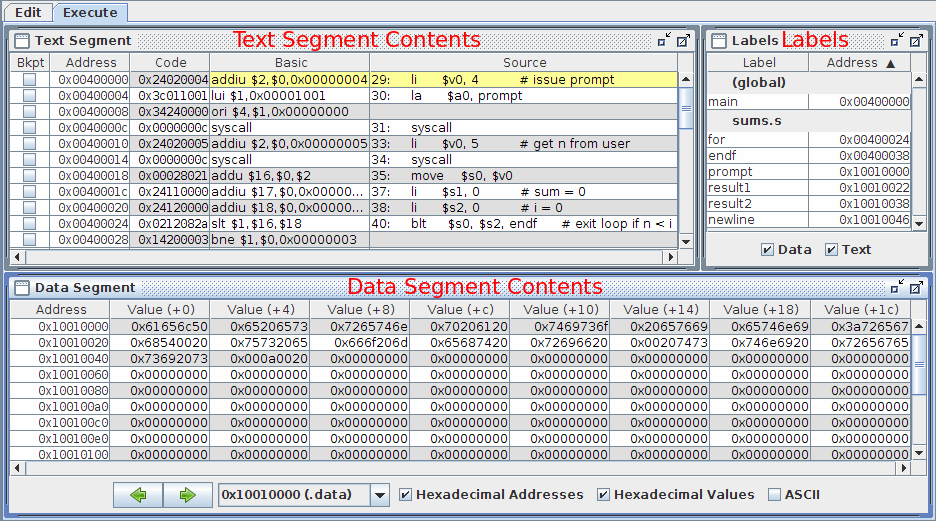Example
- MARS MIPS simulator is an assembly language editor, assembler, simulator & debugger for the MIPS processor, developed by Pete Sanderson and Kenneth Vollmar at Missouri State University ( src ). You get the MARS for free here.
- Language used to comment in the whole code is english. This program will read a bmp image and process according the user choice. MIPS assembly language and Mars 4.5 was used to achieve this task. To get the thing working, just put mars into the same folder as the main.asm file and img.bmp as well. It should work fine.
- 1.3) MARS is a full featured MIPS assembly IDE, with a built-in editor where you can enter your assembly programs and assemble them along with a simulator that will run your MIPS assembly programs and allow you to debug them. Input the Tutorial program 2.1) Open the MARS program and click from the file menu choose “FileNew”.
- This first tutorial will teach you what MIPS Assembly language is all about, and it will teach you how to download a program to start programming in MIPS.
Mars Mips Pdf
Over 40 new basic instructions were added to the MIPS-32 instruction set that MARS now assembles and simulates. The total is now 141 basic instructions. It now supports nearly all instructions from Patterson and Hennessy's Computer Organization and Design textbook.
MARS MIPS simulator is an assembly language editor, assembler, simulator & debugger for the MIPS processor, developed by Pete Sanderson and Kenneth Vollmar at Missouri State University (src).
You get the MARS for free here. As for installing the 4.5 version, you might need the suitable Java SDK for your system from here

Before assembling, the environment of this simulator can be simplisticly split to three segments: the editor at the upper left where all of the code is being written, the compiler/output right beneath the editor and the list of registers that represent the 'CPU' for our program.
After assembling (by simply pressing F3) the environment changes, with two new segments getting the position of the editor: the text segment where
i) each line of assembly code gets cleared of 'pseudoinstructions' (we'll talk about those in a sec) at the 'basic' column and
ii) the machine code for each instruction at the 'code' column,
and the data segment where we can have a look at a representation of the memory of a processor with little-endian order.
After assembling, we can execute our code either all at once (F5) or step by step (F7), as well as rewinding the execution several steps backwards to the back (F8).
Now, let's see the example code from above and explain each line:
MARS accepts and exports files with the .asm filetype
But the code above prints just a character, what about the good ol' 'Hello World'? What about, dunno, adding a number or something? Well, we can change what we had a bit for just that:
Before illustrating the results through MARS, a little more explanation about these commands is needed:
System calls are a set of services provided from the operating system. To use a system call, a call code is needed to be put to $v0 register for the needed operation. If a system call has arguments, those are put at the $a0-$a2 registers. Here are all the system calls.
li(load immediate) is a pseudo-instruction (we'll talk about that later) that instantly loads a register with a value.la(load address) is also a pseudo-instruction that loads an address to a register. Withli $v0, 4the $v0 register has now4as value, whilela $a0, strloads the string ofstrto the$a0register.A word is (as much as we are talking about MIPS) a 32 bits sequence, with bit 31 being the Most Significant Bit and bit 0 being the Least Significant Bit.
lw(load word) transfers from the memory to a register, whilesw(store word) transfers from a register to the memory. With thelw $s1, 0($t0)command, we loaded to$s1register the value that was at the LSB of the$t0register (thats what the0symbolizes here, the offset of the word), aka256.$t0here has the address, while$s1has the value.sw $t2, 0($t0)does just the opposite job.MARS uses the Little Endian, meaning that the LSB of a word is stored to the smallest byte address of the memory.
MIPS uses byte addresses, so an address is apart of its previous and next by 4.
Mips Tutorial => Getting Started With Mips
By assembling the code from before, we can further understand how memory and registers exchange, disabling 'Hexadecimal Values' from the Data Segment:
or enabling 'ASCII' from the Data Segment:
Start it like this
$ java -jar Mars4_5.jar
Create this file and save it.
Press F3 to assembly it and then press run. Now you are started compiling and executing MIPS code.